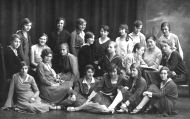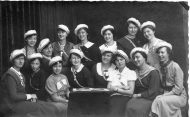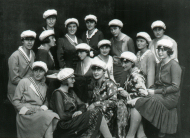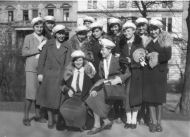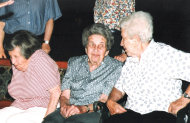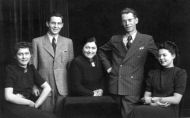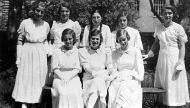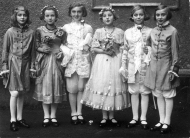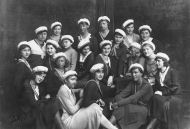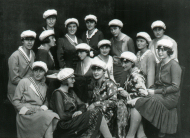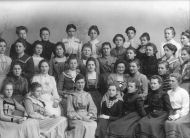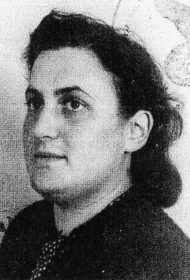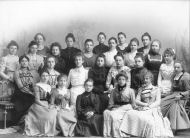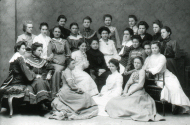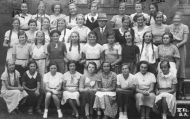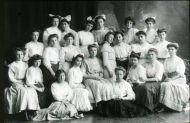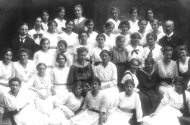|
|
|
|
|
|
|
|
|
|
|
|
|
|
|
|
|
|
|
|
|
|
|
|
|
|
|
|
|
|
|
|
|
|
|
|
|
|
|
|
|
|
|
|
|
|
|
|
|
|
|
|
|
|
|
|
|
|
|
|
|
|
|
|
|
|
|
|
|
|
|
|
|
|
|
|
|
|
|
|
|
|
|
|
|
|
|
|
|
|
|
|
|
|
|
|
|
|
|
|
|
|
|
|
|
|
|
|
|
|
|
|
|
|
|
|
|
|
|
|
|
|
|
|
|
|
|
|
|
|
|
|
|
|
|
|
|
|
|
|
|
|
|
|
|
|
|
|
|
|
|
|
|
|
|
|
|
||||||||||||||||||||||||||||||||||||||||||||||||||||||||||||||||||||||||||||||||||||||||||||||||||||||||||||||||||||||||||||||||||||||||||||||||||||||||||||||||||||||||||||||||||||||||||||||||||||||||||||||
|
Lore Lämmle Born: 1914 in Fischach. Father’s occupation: businessman in Zusmarshausen (near Augsburg). Lore’s father, Isaak Lämmle (1874–1938), ran an oils and fats business. Her mother was called Elsa, née Erlanger (1882–1936). Lore attended Maria-Theresia-School from 1924 to 1930 in classes 1–6. In 1935, Lore married Erich Liebermann from Munich. The couple lived in Munich in Elisabethstraße 14. In 1939, they emigrated with their 14-month-old daughter to the USA. Lore Lieberman, née Lämmle, died in New York in 2002. |
|
|
Dora Landauer Born: 1916 in Augsburg. Father’s occupation: factory owner. Flat: 4 Schießgrabenstraße. Company: 25 Färberstraße. The textile factory “M.S. Landauer” was situated in Augsburg-Oberhausen. Dora’s father, Paul (b. 1879 in Augsburg), was one of several co-owners from the Landauer family (the name of the company came from its founder, the weaver Moses Samuel Landauer, who was born in 1808 in Hürben—today a city district of Krumbach). In 1910, Paul Landauer married Hedwig Schnebel from Nuremberg (b. 1890). The couple had four daughters: Elsbeth, Herta, Dora, and Marianne. They all attended Maria-Theresia-School. Dora was the third child. She attended the school from 1926 to 1935 in classes 1–G9. On June 2, 1930, Dora celebrated her “confirmation” in Augsburg, together with eight other Jewish girls (Bat Mitzvah: the feast of religious maturity for Jewish girls; it can be celebrated individually after a girl’s 12th birthday, but in Augsburg it was held annually or after even longer intervals for several age groups together, similar to the Protestant confirmation). Dora passed her maturity exam (“Abitur”) in 1935. A few years later, she emigrated and married Theodor Schocken (b. 1914 in Zwickau, Saxony). Theodor was the second son of Salman Schocken (1877–1959). Salman was the owner of a firm which comprised several department stores in Germany, and he was the founder of the “Schocken Verlag” as well. This publishing house issued a wide range of Jewish literature from 1931 to 1938, when it was oppressed by the Gestapo. Among the books published by Schocken were Die Schrift, the famous translation of the Hebrew Bible into German by Franz Rosenzweig and Martin Buber, and the works of Franz Kafka. Salman Schocken emigrated to Palestine in |
1934. He founded another publishing company there and a third one in 1945 in the USA where he had fled in 1940. Theodor stayed in Germany until 1938. He worked in leading positions in his father’s department store chain as well as in the publishing house. In 1938, the firm “Schocken”—including a department store at Augsburg—was “Aryanized”. Theodor went to Palestine and later on, together with his father, to the USA. Georg Spiro, who was a cousin of Theodor and had married Dora Landauer’s sister Elsbeth, had also been a manager of the Schocken firm. Elsbeth and Georg emigrated with their children to Ramat Gan, Palestine (near Tel Aviv). Around 1938, the Landauer factory, which had been in possession of the Landauer family for four generations, had to be sold below value and was “Aryanized”, too. In 1939, Dora’s parents, Paul and Hedwig Landauer, emigrated to Ramat Gan just like their daughter Elsbeth. Dora herself emigrated to the USA, where she and Theodor Schocken—who called himself “Theodore” by now—married in 1941. Around that time, Dora got her B.A. in social working. Theodore fought against national socialist Germany in the US Army. After the war, he worked for his father’s American publishing house. For some time, he was a member of the board of the German firm “Merkur AG”, into which the Schocken department stores had been transformed. After Salman’s death in 1959, Theodore and his brother-in-law, Herzl Rome, took over Schocken Books. Today, Schocken Books is a division of Random House Inc.. |
Dora and Theodore had three daughters. Theodore died in 1975, he was 60 years old. Dora’s parents both died in Ramat Gan, Israel: Paul in 1976, Hedwig in 1979. Dora was a social worker at Grasslands Hospital (Westchester County Medical Center), Westchester, New York. Dora Schocken, née Landauer, died in Longmeadow, Massachusetts, in 2005. (Dora Schocken’s daughter Naomi Landau added to this biography of her mother.) Sources and further reading: Augsburg State Archives, copy of a chronicle of the company “M. S. Landauer”. The appendix, “Die Nachfahren des M. S. Landauer und seiner Frau Klara aus Hürben bei Krumbach,” ends with March 15, 1936. Obituary of Dora Schocken, née Landauer, New York Times, May 7, 2005. Obituary of Theodore Schocken, Time, March 31, 1975. Anthony David, The Patron: A Life of Salman Schocken, 1877–1959, New York, 2003. Konrad Fuchs, Ein Konzern aus Sachsen. Das Kaufhaus Schocken als Spiegelbild deutscher Wirtschaft und Politik 1901 bis 1953, Stuttgart, 1990. Saskia Schreuder and Claude Weber, in conjunction with Silke Schaeper and Frank Grunert, eds., Der Schocken Verlag / Berlin. Jüdische Selbstbehauptung in Deutschland 1931–1938. Essayband zur Ausstellung “Dem suchenden Leser unserer Tage” der Nationalbibliothek Luxemburg, Berlin, 1994. |
|
|
Elsbeth Landauer Born: 1911 in Augsburg. Father’s occupation: factory owner. Flat: 10½ / II Frölichstraße. Company: 25 Färberstraße. The textile factory “M. S. Landauer” was situated in Augsburg-Oberhausen. Elsbeth’s father, Paul (b. 1879 in Augsburg), was one of several co-owners from the Landauer family (the name of the company came from its founder, the weaver Moses Samuel Landauer, who was born in 1808 in Hürben—today a city district of Krumbach). In 1910, Paul Landauer married Hedwig Schnebel from Nuremberg (b. 1890). The couple had four daughters: Elsbeth, Herta, Dora, and Marianne. They all attended Maria-Theresia-School. Elsbeth was the eldest daughter. She attended the school from 1924 to 1930 in classes G4–G9 and passed her maturity exam (“Abitur”) in 1930; presumably, she had joined the school in 1921 in class 1. In May 1925, Elsbeth celebrated her “confirmation” in Augsburg, together with nine other Jewish girls (Bat Mitzvah: the celebration of religious majority for Jewish girls, which can be celebrated individually on the Sabbath after the girl’s 12th birthday; in Augsburg, however, similar to the Protestant confirmation, it was held annually or even after longer intervals for several age groups at the same time). In 1932, Elsbeth married Georg Spiro (b. 1896 in Znin, today Poland). Until 1933, he was Director of the chainstore “Schocken” in Augsburg, Untere Maximilianstraße C 7 (today No. 11), then General Manager of the company in Zwickau (Saxony); one of his cousins was Theodor Schocken, the husband of Elsbeth’s sister Dora. Elsbeth’s first child was born in Augsburg in 1933, the second child followed in Zwickau in 1935. The family Spiro emigrated to Palestine in 1938. The Schocken department stores were “Aryanized”, the new name of the firm was “Merkur”. Elsbeth’s third child was born in Ramat Gan (near Tel Aviv) in 1939. |
|
|
|
Herta Landauer Born: 1912 in Augsburg. Father’s occupation: factory owner. Flat: 10½ / II Frölichstraße. Company: 25 Färberstraße. The textile factory “M. S. Landauer” was situated in Augsburg-Oberhausen. Herta’s father, Paul (b. 1879), was one of several co-owners from the Landauer family (the name of the company came from its founder, the weaver Moses Samuel Landauer, who was born in 1808 in Hürben—today a city district of Krumbach). In 1910, Paul Landauer married Hedwig Schnebel from Nuremberg (b. 1890). The couple had four daughters: Elsbeth, Herta, Dora, and Marianne. They all attended Maria-Theresia-School. Herta was the second eldest. She attended the school from 1924 to 1931 in classes 3–G9 and passed her maturity exam (“Abitur”) in 1931; presumably, she had joined the school in 1922 in class 1. Herta married the art historian Ernst Leopold Neustätter from Munich. The couple emigrated to Florence, Italy, in 1934. Several years later, they moved to the USA and changed their name to Newton. Around 1938, the Landauer factory in Augsburg, which had been in possession of the Landauer family for four generations, had to be sold under value and was “Aryanized”. In 1939, Herta’s parents emigrated to Ramat Gan, Palestine (near Tel Aviv), just like their daughter Elsbeth and her family. Paul died there in 1976, his wife, Hedwig, in 1979. Herta and Ernest Newton had two children. Herta was a photographer specializing in children’s photography. In 1981, she contributed many photographs to a scientific catalogue of chinese rubbings. Ernest worked as an accountant. He died in Chicago in 1993. Herta Newton, née Landauer, died in Chicago in 2005. |
|
|
|
Marianne Landauer Born: 1920 in Augsburg (no place of birth is given in the Annual School Reports). Father’s occupation: factory owner. Flat: 10½ / II Frölichstraße. Company: 25 Färberstraße. The textile factory “M. S. Landauer” was situated in Augsburg-Oberhausen. Marianne’s father, Paul (b. 1879), was one of several co-owners from the Landauer family (the name of the company came from its founder, the weaver Moses Samuel Landauer, who was born in 1808 in Hürben—today a city district of Krumbach). In 1910, Paul Landauer married Hedwig Schnebel from Nuremberg (b. 1890). The couple had four daughters: Elsbeth, Herta, Dora, and Marianne. They all attended Maria-Theresia-School. Marianne was the youngest. She joined the school in class 1 in 1931 and attended the grammar school section (“Gymnasialzweig”) until the 6th grade. In 1935, Marianne celebrated her “confirmation” in Augsburg, together with some other Jewish girls (Bat Mitzvah: the feast of religious majority for Jewish girls, which can be celebrated individually after the 12th birthday of the girl; in Augsburg, however, it was celebrated, similar to the Protestant confirmation, annually or even after longer intervals for several age groups together). Marianne dropped out of the school on March 24, 1937. In Munich, she had herself trained as a kindergarten teacher. Around 1938, the Landauer factory, which had been in possession of the Landauer family for four generations, had to be sold under value and was “Aryanized”. In 1939, Marianne’s parents, Hedwig and Paul Landauer, emigrated to Ramat Gan, Palestine (near Tel Aviv), just like their daughter Elsbeth and her family. Marianne went with them. |
|
|
|
Irma Landmann Born: 1923 in Augsburg (no place of birth is given in the Annual School Reports). Father’s occupation: businessman. Flat: 3 Hermanstraße. Company: 41 Ravenspurgerstraße. Irma’s father was the fur-trader Joseph Landmann (b. 1895 in Zaslaw, Galicia, today’s Izyaslav, Ukraine). Irma’s mother was called Regina, née Grünebaum (b. 1891 in Hellstein). Like Irma, her sister Johanna Landmann and her cousin Auguste Wolf attended Maria-Theresia-School. Irma attended Maria-Theresia-School from 1934 to 1938 in classes 1–3, G4 and L5. The 15-year-old Irma was forced by Government Decree to drop out of school during the school year on November 14, 1938. Irma’s brother, Heinz (b. 1920), was arrested after the November pogrom in 1938 and deported, together with his father Joseph, to the Dachau concentration camp. As they could prove that their emigration had already been applied for, they were released after several weeks. First Joseph emigrated, via Great Britain, to the USA, then Heinz followed; while Heinz was still waiting in London, his mother and both of his sisters were able to travel to the USA. Heinz, who now called himself Henry Landman, returned to Augsburg as an American soldier during the capture of the city in 1945. During the war, Irma worked as an auxiliary nurse at a hospital in New York and completed her military service in a medical laboratory of the Women’s Army Corps. She married Guy Avery and had a daughter. Together with Guy, she ran a restaurant in New York. Irma Avery, née Landmann, died in New York in 1985. Irma’s grandparents, Gerson (b. 1858) and Sofie Landmann (b. 1868), had moved from Galicia to Munich in 1901. They were deported to Terezin in June 1942 and only survived a few days: Sofie died on June 19, Gerson on July 13 that year. |
Sources and further reading: Richard Landman, “Photo Album for the Landman Family of Augsburg, Germany,” on his website: www.infotrue.com/landman.html (as of May 2008). Andreas Heusler, Brigitte Schmidt, Eva Ohlen, Tobias Wege, and Simone Dicke, Biographisches Gedenkbuch der Münchner Juden 1933–1945, vol. 1 (A–L), ed. Munich City Archives (“Stadtarchiv München”), Munich, 2003, pp. 777 and 779 (on Gerson and Sofie Landmann). Johanna Landmann, Letter of 1943; excerpt: Ernst Jacob, Circular No. 6, September 1943, Gernot Römer, ed., “An meine Gemeinde in der Zerstreuung.” Die Rundbriefe des Augsburger Rabbiners Ernst Jacob 1941–1949, Augsburg, 2007, pp. 74–80, p. 78. Gernot Römer, Die Austreibung der Juden aus Schwaben. Schicksale nach 1933 in Berichten, Dokumenten, Zahlen und Bildern, Augsburg, 1987, pp. 219–27. Gernot Römer, “Wir haben uns gewehrt.” Wie Juden aus Schwaben gegen Hitler kämpften und wie Christen Juden halfen, Augsburg, 1995, pp. 82, 87–101. Paul Rosenau and Henry Landman, “Erinnerungen an die 20er und 30er Jahre in Augsburg,” Peter Fassl, ed., Geschichte und Kultur der Juden in Schwaben, vol. 2: Neuere Forschungen und Zeitzeugenberichte, Stuttgart, 2000, pp. 319–37. |
|
|
Johanna Landmann Born: 1921 in Augsburg (no place of birth is given in the Annual School Reports). Father’s occupation: businessman. Flat: 3 Hermanstraße. Company: 41 Ravenspurgerstraße. Johanna’s father was the fur-trader Joseph Landmann (b. 1895 in Zaslaw, Galicia, today’s Izyaslav, Ukraine). Johanna’s mother was called Regina, née Grünebaum (b. 1891 in Hellstein). Like Johanna, her sister Irma Landmann and her cousin Auguste Wolf attended Maria-Theresia-School. Johanna had an elder brother, Heinz (b. 1920). Johanna attended Maria-Theresia-School from 1932 to 1936 in classes 1–4. Together with her cousin Gusti Wolf, she dropped out of the school on April 2, 1936, before the end of the school year. Both girls were accepted by the secondary-school-sector of the convent school St. Elisabeth (convent of the Franciscan nuns, “Maria Stern”). Margot Herrmann (b. 1921), another Jewish girl who was also in their class, had transferred from the “A.B. von Stettensches Institut”, a private secondary school for girls. (Margot was deported to Piaski, Poland, in 1942.) Sister M. Edelwina (née Kunigunde) Hutzmann attended the same class at that time and later worked at St. Elisabeth from 1945 on, mainly as a needlework teacher. Today she still remembers that the relationship between the pupils was very affectionate, without regard to religion (interview in October 2005). Johanna was among the nine girls who celebrated their “confirmation” in Augsburg in May 1937, as well as Gusti Wolf and Marianne Weil (Bat Mitzvah: the celebration of religious majority for Jewish girls, which can be held individually on the Sabbath after a girl’s 12th birthday; in Augsburg, however, similar to the Protestant confirmation, it was held annually or even after longer intervals for several age groups at the same time). |
Johanna’s brother, Heinz, was arrested after the November pogrom in 1938 and deported, together with his father Joseph, to the Dachau concentration camp. Because they could prove that their emigration had already been applied for, they were released after several weeks. First Joseph emigrated, via Great Britain, to the USA, then Heinz followed; while Heinz was still waiting in London, his mother and both of his sisters were able to travel to the USA. Heinz, who now called himself Henry Landman, returned to Augsburg as an American soldier during the capture of the city in 1945. In the USA, Johanna (“Hanni”) stayed in contact with Ernst Jacob, the former rabbi of Augsburg. In the fifth circular written to Augsburg’s former Jewish community from Springfield, Missouri, Jacob quotes a letter Hanni had sent him from New York: “I am eager to become a good and loyal American. What I was taught in Germany, however, will remind me forever not to deny my inheritance: to become a better and better Jew all life long.” During the war, Johanna—who now called herself Joan—worked as an auxiliary nurse at a hospital in New York. She married Sol Weinstein; the couple had a daughter. Joan worked as a fur seamstress. Joan Weinstein, née Johanna Landmann, died in New York in 1970. Johanna’s grandparents, Gerson (b. 1858) and Sofie Landmann (b. 1868), had moved from Galicia to Munich in 1901. They were deported to Terezin in June 1942 and only survived a few days: Sofie died on June 19, Gerson on July 13 that year. |
Sources and further reading: Richard Landman, “Photo Album for the Landman Family of Augsburg, Germany,” on his website: www.infotrue.com/landman.html (as of May 2008). Andreas Heusler, Brigitte Schmidt, Eva Ohlen, Tobias Weger, and Simone Dicke, Biographisches Gedenkbuch der Münchner Juden 1933–1945, vol. 1 (A–L), ed. Munich City Archives (“Stadtarchiv München”), Munich, 2003, pp. 777 and 779 (on Gerson and Sofie Landmann). Johanna Landmann, Two letters of 1943; excerpts: Ernst Jacob, Circulars No. 5, April 1943, and No. 6, September 1943, Gernot Römer, ed., “An meine Gemeinde in der Zerstreuung.” Die Rundbriefe des Augsburger Rabbiners Ernst Jacob 1941–1949, Augsburg, 2007, pp. 65–73, pp. 68–69, and pp. 74–80, p. 78. Gernot Römer, Die Austreibung der Juden aus Schwaben. Schicksale nach 1933 in Berichten, Dokumenten, Zahlen und Bildern, Augsburg, 1987, pp. 219–27. Gernot Römer, “Wir haben uns gewehrt.” Wie Juden aus Schwaben gegen Hitler kämpften und wie Christen Juden halfen, Augsburg, 1995, pp. 82, 87–101. Paul Rosenau and Henry Landman, “Erinnerungen an die 20er und 30er Jahre in Augsburg,” Peter Fassl, ed., Geschichte und Kultur der Juden in Schwaben, vol. 2: Neuere Forschungen und Zeitzeugenberichte, Stuttgart, 2000, pp. 319–37. Irmgard Hirsch-Erlund, Irmgard. Eine jüdische Kindheit in Bayern und eine Vertreibung, ed. Gernot Römer, Augsburg, 1999, pp. 96–97 (on the Bat Mitzvah of 1937). |
|
Margot Lehrburger Born: 1921 in Augsburg (no place of birth is given in the Annual School Reports). Father’s occupation: chemist. Margot’s father was Dr. Karl Lehrburger (b. 1880 in Munich), her mother was Ida, née Löwenthal (b. 1881 in Hörstein). Karl Lehrburger owned the “Chemical Factory” in Haunstetten (near Augsburg). Margot attended Maria-Theresia-School from 1932 to 1934 in classes 1–3. In 1933, her parents got divorced; in August that year, her father was imprisoned in the Dachau concentration camp. On May 30, 1934—during the school year—, the 12-year-old Margot dropped out of Maria-Theresia-School. Her mother emigrated to the USA that year and took her children with her, Margot and her brother, Norbert (b. 1919). Karl’s imprisonment lasted until May 1937. In 1938, he could emigrate, via Prague, to Palestine. He worked as a chemical engineer in Haifa; in 1945, he died in an auto accident. In the USA, Margot married Morris Ray in 1942; the couple had two children. Margot worked as a secretary for textile firms. Margot’s mother, Ida, died in New York in 1976. Margot Ray, née Lehrburger, died in Florida in 2000. She is buried in New York. Source: Gernot Römer, ed., “An meine Gemeinde in der Zerstreuung.” Die Rundbriefe des Augsburger Rabbiners Ernst Jacob 1941–1949, Augsburg, 2007, p. 290. |
Mira Lemle Born: 1888 in Fischach. Father’s occupation: trader in Fischach. Mira’s father, Samson Lemle (1858–1912), was a cattle dealer in Fischach. Her mother, Mina, née Rothschild (1863–1911), was born in Buttenwiesen. Mira attended Augsburg’s “Municipal School for Daughters” (“Städtische Töchterschule”), which later was to be called “Maria-Theresia-School”, from 1901 to 1904 in classes 1, 2 and 4. Mira died in 1936. She was buried in the Jewish cemetery of Fischach. Her tombstone bears an inscription in Hebrew and German. In the Hebrew part, Mira is called “Mirjam the wife”. The stone next to hers was erected in memory of Albert Fromm (1876–1936). The two stones resemble each other very closely as would be expected of the stones of a married couple. Source: Andreas Angerstorfer, Der Jüdische Friedhof in Fischach. Aufnahme der 403 noch vorhandenen Grabstätten mit ihren noch lesbaren hebräischen und deutschen Inschriften (2000–2004), Regensburg, 2004 (not published; a copy is to be found at Fischach’s City Hall). |
|
|
Anneliese Lerchenthal Born: 1913 in Augsburg. Father’s occupation: banker. Flat: 2 Hochfeldstraße. Anneliese’s father, MD Robert Lerchenthal (b. 1880 in Gostenhof), was an associate of the “Bankhaus August Gerstle”. Anneliese’s mother was called Alice (“Liesl”), née Schwartz (b. 1885 in Greiz). Just like Anneliese, also her older sister Gertrud attended Maria-Theresia-School. Anneliese, “Anneli”, attended Maria-Theresia-School from 1924 to 1932 in classes 2–G9 and passed her maturity exam (“Abitur”) in 1932; presumably, she had joined the school in 1923 in class 1. She was a classmate of Lotte Dann; Lotte Treves, née Dann, about her friend: “Anneli had an artistic nature. She was very beautiful with deep blue eyes and pitch-black hair, always deeply tanned because the family went hiking in the mountains in Summer and skiing in Winter; besides her beauty, she was distinctive and remarkable, so that she had a boyfriend already at the age of 15, which was extraordinary at that time, and, in addition, she had countless admirers. Our friendship began all of a sudden in Autumn 1928 and lasted as long as Anneli lived.” In 1929, Anneli’s mother Liesl died. In 1936, Anneli emigrated, via Paris, to London. There she met Claud Bunyard and married him. In the second half of the year 1940, while her husband was doing his military service and she already had her little son, her friend Lotte Dann lived with her. In the 1940s, Anneli worked as a photographer for the fashion magazine Vogue. She portrayed British actors and also contributed a series of photographs to a little book: What a Thread Can Do. It was a non-fiction book for children which showed the mechanical manufacturing of clothes from the raw material to the finished garment. The full-page colour photographs each come with a text page and a number of charcoal drawings. |
Anneli Bunyard, née Lerchenthal, died in a traffic accident in Rome on New Year’s Eve 1950. Anneli’s sister, Gertrud, left Germany in 1933; after a couple of years, she settled in New Zealand with her family. Robert Lerchenthal followed his eldest child and emigrated to New Zealand in 1937. He founded a chemical factory there. In 1956, he died in Akaroa, New Zealand. Anneli’s brother, Hans Rudolf Lerchenthal (b. 1917), died in a mountaineering accident in New Zealand in 1946. (Anneli’s son, Peter Bunyard, added to this brief biography of his mother.) Sources and further reading: |
|
|
Gertrud Lerchenthal Born: 1911 in Augsburg. Father’s occupation: banker. Flat: 2 Hochfeldstraße. Gertrud’s father, MD Robert Lerchenthal (b. 1880 in Gostenhof), was an associate of the “Bankhaus August Gerstle”. Gertrud’s mother was called Alice (“Liesl”), née Schwartz (b. 1885 in Greiz). Just like Gertrud, also her younger sister Anneliese attended Maria-Theresia-School. Gertrud attended Maria-Theresia-School from 1924 to 1930 in classes G4–G9; presumably, she had joined the school in 1921 in class 1. In May 1925, Gertrud celebrated her “confirmation” in Augsburg, together with nine other Jewish girls (Bat Mitzvah: the feast of religious majority for Jewish girls, which can be celebrated individually on the Sabbath after the 12th birthday of the girl; in Augsburg, however, it was celebrated, similar to the Protestant confirmation, annually or even after longer intervals for several age groups together). Gertrud has talked to her son Claude about her school years. She “was a very good student, loved learning and reading and was habitually one of the top three students in her class—she said they were always competing with each other. ... She had a very happy childhood, adored and respected her father (an expert Alpinist) and often went with him during her youth climbing in the Alps, particularly the Dolomites” (C. Kahn in a letter, October 2006). In 1929, Gertrud’s mother Liesl died. Gertrud passed her maturity exam (“Abitur”) in 1930. Then she went to Munich University, where she first met her future husband, Joachim-Friedrich Kahn (b. 1907). The couple married in Augsburg in 1932. (Joachim was a half brother of Ruth Kahn.) In 1933, immediately after graduating to the Bar, Joachim was debarred from practicing as a lawyer by anti-Jewish legislation. Gertrud and |
|
|
Elsa Levinger Born: 1886 in Augsburg. Father’s occupation: manufacturer. Just like Elsa, also her older sister Karoline attended the “Municipal School for Daughters” (“Städtische Töchterschule”), which later was to be called “Maria-Theresia-School”. Elsa was an aunt of Hildegard Levinger. Elsa attended the “Töchterschule” from 1898 to 1902 in classes 1–4; the fourth class was the school-leaving class in those times. Elsa’s married name was Türkheimer. In 1916, her daughter Gertrud Türkheimer was born. The family lived on Haunstetter Straße. For some time, Gerda Ruppin and her parents lived in the same house. Elsa emigrated to Brazil, as well as her daughter Gertrud and Gertrud’s family. In 1949, Elsa lived in Curitiba. |
|
Hildegard Levinger Born: 1918 in Augsburg (no place of birth is given in the Annual School Reports). Father’s occupation: factory owner. Flat: 4 Hochfeldstraße. Hildegard’s father, Siegfried Levinger (b. 1881 in Hürben), was a shoe manufacturer and co-owner of the shoe wholesale “Sigmund Levinger”. Hildegard’s mother was called Gertrud, née Jeidel (b. 1893). Gertrud died in 1929 while Hildegard still attended school. Hildegard had an elder brother, Max (b. 1916). Hildegard was a niece of Elsa and Karoline Levinger and a cousin of Gertrud Türkheimer. Hildegard attended Maria-Theresia-School from 1929 to 1934 in classes 1–5. On March 22, 1934, she left the school without graduating at the age of 15. Due to the anti-Jewish boycotts organized from 1933 onwards, the sales of the shoe factory owned by Siegfried and his brother fell off. In 1935, the company was sold in a compulsory auction. Hildegard became a clerk. At the beginning of 1936, she transferred to Munich. In 1938, Hildegard began looking for a chance to emigrate. In May 1939, she was refused a passport because she had not yet paid the special tax imposed on the Jews at the end of 1938 (“Judenvermögensabgabe”). In July 1940, Hildegard married the office worker Walter Wilmersdörfer (b. 1909). On April 4, 1942, the couple was deported to Piaski, Poland. Hildegard is pronounced dead. For two months, from April to June 1942, the engineer Arnold Hindls from Brno, Moravia, also lived in Piaski. For him this was but one of many deportation stations, between Terezin and Ossovo. In his memoirs, One Man Returned, published in Germany in 1965, he tells about Piaski: “Piaski is a small town in the Lublin district, surrounded by sand, swamps, and forests. The state road from Lublin to Chelm divides it into two parts. Therefore, the Jewish ghetto, which once was very large and inhabited by approx. 3000 local Jews, extended on both sides of the state road. Now, however, these two parts of the ghetto were each |
enclosed by high fences made of boards and barbed wire. They had big gates, which were permanently guarded and opened only twice a day, for one hour in the morning and one in the afternoon. The gates were closed towards the state raod. ... The houses of the ghetto were mostly made of wood. They had only small yards and were closely boxed together, mostly built on ground level, only a few had one story. ...The small town had neither plumbing nor sewer. For the approx. 6000 inhabitants of the two parts of the ghetto...there was only one well with acceptable drinking water in the southern part. Each person was allowed to fetch only one ten litre bucket a day from that well. ... The SS commando which was in charge of the ghetto was stationed in a large, solid building on the outskirts of the southern part of the ghetto, at the state road. The SS could well observe both parts of the ghetto from the balcony of the building. Every visit by those ‘members of the master race’ meant slaps, kicks, and beatings. They confiscated food which was ‘not allowed’ and smuggled into the ghetto. ...Twenty to thirty people, nothing but skin and bones, died of hunger every day. ... In spite of these catastrophic provision conditions, all men and women who were able to work were recruited into groups to do excavation, gardening, and upkeep of the roads. ...Also within the ghetto, there was enough work to do, for instance, the cleaning and deepening of the drainage and gravel ditches, and the construction of latrines, latrines, and more latrines, of which there were never enough.” |
In the autumn of 1942, some Jews were taken from Piaski to Belzec, the others, approx. 4000, were taken to Sobibor, where they were killed. Immediately thereafter, the Piaski ghetto was occupied anew by other deported Jews. – Hildegard’s father, Siegfried Levinger, emigrated to Milan, Italy, in 1939 at the latest. He died in 1962. Hildegard’s brother, Max, fled to Italy in 1938, then to Curitiba, Brazil, where his aunt Elsa Türkheimer lived, and at last to New York, where he died in 1949. Hildegard Wilmersdörfer’s name is listed on a glass plaque of the shoah memorial which can be visited in Augsburg’s City Hall (artist: Klaus Goth). Sources and further reading: Andreas Heusler, Brigitte Schmidt, Eva Ohlen, Tobias Weger and Simone Dicke, with the collaboration of Maximilian Strnad, Biographisches Gedenkbuch der Münchner Juden 1933–1945, vol. 2 (M–Z), ed. Munich City Archives (“Stadtarchiv München”), Munich, 2007, pp. 777–78. Arnold Hindls, Einer kehrte zurück. Bericht eines Deportierten, Stuttgart, 1965, pp. 12–32. Maren Janetzko, “Anfänge der ‘Arisierung’ in Augsburg,” Michael Cramer-Fürtig, Bernhard Gotto, eds., “Machtergreifung” in Augsburg. Anfänge der NS-Diktatur 1933–1937, Augsburg, 2008, pp. 159–66, esp. 161 (on the Levinger shoe factory). |
|
Karoline Levinger Born: 1884 in Augsburg. Father’s occupation: manufacturer. Just like Karoline, also her younger sister Elsa attended the “Municipal School for Daughters” (“Städtische Töchterschule”), which later was to be called “Maria-Theresia-School”. Karoline was an aunt of Hildegard Levinger and Gertrud Türkheimer. Karoline attended the “Töchterschule” from 1897 to 1901 in classes 1–4; the fourth class was the school-leaving class in those times. |
|
Rosa Lieblich Born: 1887 in Augsburg. Father’s occupation: businessman. Rosa attended the “Municipal School for Daughters” (“Städtische Töchterschule”), which later was to be called “Maria-Theresia-School”, from 1899 to 1903 in classes 1–4; the fourth class was the school-leaving class in those times. Rosa (aka Rosel) later lived in Mannheim under her husband’s name, Wolff. On October 22, 1940, she was deported to Gurs, South of France, together with approx. 7500 Jews from Baden and the Saar-Palatinate. “As a complete shock for those concerned, in the morning there appeared members of the Gestapo, the gendarmerie or the auxiliary police in front of their apartments and ordered them to get ready for transport. They were allowed to take with them 50 kg luggage and 100 Reichsmark for each adult person. ...They began an odyssey through France by train which lasted several days. The conquered nation was obliged to take in those who were driven out of their German homeland. The French authorities, catched unawares by the presumption, hastily looked for accomodations. They found the camps made of huts which had been built to accomodate hundreds of thousands of refugees after the collapse of the Spanish Republic in Spring 1939 and were inhabited only sparsely now. One of those camps was located near Gurs, a small town on the edge of the Pyrenees. ...The huts had been meant to be used only for a short time, they had, however, hosted changing inhabitants for more than a year, so they were in poor condition. The mostly elderly deportees also suffered from the poor weather, the poor food, and often from their already poor state of health. Many of them died exhausted already in the first winter” (H.-J. Hirsch). |
The female deportees were received at the blocks designated for women by a few hundred internees who lived there since May 1940. When the war between Germany and France began to be fought, more than 2000 single women—or married women without children—who had the German nationality but lived in France had been interned in Gurs. In Summer 1940, many of those women hadbeen able to flee from the camp, others, mostly Jews, however, had been unable or unwilling to do so. (Among those who still were interned at the camp was Marie Bach.) |
|
|
Gertrud Loeb Born: 1921 in Augsburg (no place of birth is given in the Annual School Reports). Father’s occupation: businessman. Store: “Weberhaus”, Moritzplatz. Gertrud’s parents were Bernhard Loeb (b. 1893 in Augsburg) and Rosa, née Grünhut (b. 1895 in Regensburg). Bernhard owned the fashion shop “Max Ginsberger & Co.”, which was located at the “Weberhaus” near Maximilianstraße. Gertrud had a younger brother, Fritz (b. 1925). Gertrud attended Maria-Theresia-School from 1931 to 1937 in classes 1–5 and L6. In 1935, Gertrud celebrated her “confirmation” in Augsburg, together with some other Jewish girls (Bat Mitzvah: the feast of religious majority for Jewish girls, which can be celebrated individually on the Sabbath after the 12th birthday of the girl; in Augsburg, however, it was celebrated, similar to the Protestant confirmation, annually or even after longer intervals for several age groups together). At the end of 1936, the property department of the city council refused to renew the lease of the room that hosted Bernhard Loeb’s store; the Weberhaus was the property of the City of Augsburg. Bernhard had to sell the store. During the war, Gertrud did forced labour in the Augsburg balloon factory, just like many other Jewish girls and women. On April 1, 1942, at the age of 21, she was deported to Piaski, Poland, and from then on was regarded as missing, the same as her brother, Fritz, and her parents, Bernhard and Rosa Loeb. For two months, from April to June 1942, the engineer Arnold Hindls from Brno, Moravia, also lived in Piaski. For him this was but one of many deportation stations, between Terezin and Ossovo. In his memoirs, One Man Returned, published in Germany in 1965, he tells about Piaski: “Piaski is a small town in the Lublin district, surrounded by sand, swamps, and forests. The state road from Lublin to Chelm divides it into two parts. Therefore, the Jewish ghetto, which once |
was very large and inhabited by approx. 3,000 local Jews, extended on both sides of the state road. Now, however, these two parts were each enclosed by high fences made of boards and barbed wire. They had big gates, which were permanently guarded and opened only twice a day, for one hour in the morning and one in the afternoon. The gates were closed towards the state road. ... |
In the autumn of 1942, some Jews were taken from Piaski to Belzec, the others, approx. 4,000, were taken to Sobibor, where they were killed. Immediately thereafter, the Piaski ghetto was occupied anew by other deported Jews. |
|
Martha Löwenstein Born: 1892 in Stuttgart. Father’s occupation: man of independent means. Martha’s parents were the former banker Liebmann (Lippmann) Löwenstein (b. 1854 in Heilbronn) and Elise, née Löwengard (b. 1871 in Hechingen). Liebmann died in 1899 when his daughter Martha was only seven years old. Martha attended the “Municipal School for Daughters” (“Städtische Töchterschule”), which later was to be called “Maria-Theresia-School”, from 1903 to 1908 in classes 1–5; the fifth class was the school-leaving class in those times. In December 1928, Martha married the taxi driver Karl Joseph Maria von La Hausse (b. 1896 in Munich). Karl Joseph lived in Niederndorf near Kufstein, Austria. Martha’s mother, Elise, moved to Munich that year, where she died in 1939. Sources: Andreas Heusler, Brigitte Schmidt, Eva Ohlen, Tobias Weger and Simone Dicke, Biographisches Gedenkbuch der Münchner Juden 1933–1945, vol. 1 (A–L), ed. Munich City Archives (“Stadtarchiv München”), Munich, 2003, p. 855 (on Martha’s mother, Elise Löwenstein). Family tree of the von La Hausse family, on the following website: http://genealogies.ternois.free.fr (as of May 2008). |
Elsa Luchs Born: 1898 in Binswangen. Father’s occupation: horse dealer. Address: 18 Bahnhofstraße, Augsburg. Elsa’s parents were Siegmund Luchs (b. 1868) and Paula, née Günzburger. Like Elsa, also her younger sisters Ida and Senta attended Maria-Theresia-School. The girls had one brother, Stefan (b. 1904 in Augsburg). Elsa was a cousin of Selma, Irma, and Nora Metzger. Elsa attended the “Municipal School for Daughters” (“Städtische Töchterschule”), which later was to be called “Maria-Theresia-School”, from 1909 to 1914 in classes 1–6. Elsa emigrated to Sao Paulo, Brazil, in the beginning of 1941 at the latest. Her brother Stefan did so as well. In Sao Paulo, Elsa ran a factory for pajamas. Later, she married Hans Scheidemann. Elsa Scheidemann, née Luchs, died in Sao Paulo in 1984. Source: Family tree of Elsa (Else) Luchs, on JewishGen’s website The Family Tree of the Jewish People: www.jewishgen.org/gedcom (as of April 2007). |
|
|
Ida Luchs Born: 1901 in Augsburg. Father’s occupation: horse dealer. Address: 18 Bahnhofstraße. Ida’s parents were Siegmund Luchs (b. 1868) and Paula, née Günzburger. Ida as well as her sisters Elsa and Senta attended Maria-Theresia-School. The girls had one brother, Stefan (b. 1904 in Augsburg). Ida was a cousin of Selma, Irma, and Nora Metzger. Ida attended the “Municipal School for Daughters” (“Städtische Töchterschule”), which was called “Maria-Theresia-School” in 1914, from 1911 to 1917 in classes 1–6. Ida married Dr. Julius Mändle in 1929. The couple had a daughter. Source: Family tree of Ida Luchs, on JewishGen’s website The Family Tree of the Jewish People: www.jewishgen.org/gedcom (as of April 2007). |
Senta Luchs Born: 1905 in Augsburg. Father’s occupation: horse dealer. Address: 18 Bahnhofstraße. Senta’s parents were Siegmund Luchs (b. 1868) and Paula, née Günzburger. Like Senta, also her older sisters Elsa and Ida attended Maria-Theresia-School. The girls had one brother, Stefan (b. 1904 in Augsburg). Senta was a cousin of Selma, Irma, and Nora Metzger. Senta attended Maria-Theresia-School from 1915 to 1920 in classes 1–5; presumably, she completed the sixth grade in 1920/21. Source: Family tree of Senta Luchs, on JewishGen’s website The Family Tree of the Jewish People: www.jewishgen.org/gedcom (as of April 2007). |
Antonie Lustig Born: 1904 in Laufen. Father’s occupation: businessman. (Her father’s occupation is not given in the Annual School Report.) Antonie’s parents were Heinrich Lustig (1868–1929) and Rosalie (Rosa), née Eigner (1873–1934). Like Antonie, her sisters Ernestine, Martha, and Olga also attended Maria-Theresia-School. Antonie attended Maria-Theresia-School in 1916/17 in class 2b, and perhaps also in the following year, 1917/18. Around 1930, Antonie married MD Ernst Steinitz (b. 1907 in Breslau / Wroclaw) and from then on lived with him in Wroclaw. She worked as a nurse. The couple emigrated to Palestine. In 1939, a daughter was born to them. In 1945, Ernst was a captain of the British troops stationed in India. He died in Jerusalem in 1980. Antonie Steinitz, née Lustig, died in Arad, Israel, in 1990. |
Ernestine Lustig Born: 1902 in Munich. Father’s occupation: businessman. Ernestine’s parents were Heinrich Lustig (1868–1929) and Rosalie (Rosa), née Eigner (1873–1934). Like Ernestine (Erna), also her sisters Antonie, Martha, and Olga attended Maria-Theresia-School. When Ernestine joined the school, its name still was “Municipal Secondary School for Girls” (“Städtische Höhere Mädchenschule”). Only from 1914 on, it was called “Maria-Theresia-School”. Ernestine attended the school from 1913 to 1916 in classes 1–3. In 1929, Ernestine married the white collar worker Ludwig Grünbaum (b. 1901 in Nuremberg). The couple lived in Augsburg on Rosenaustraße. Together with his father, Martin Grünbaum, Ludwig was the manager of a branch of the firm “Miele” (electrical appliances). In 1938, Ernestine and Ludwig transferred to Berlin; in November 1939, they emigrated to the USA. In San Diego, Ludwig, who now called himself Louis Gruenbaum, ran an electrical shop. Ernestine Gruenbaum, née Lustig, died in San Diego in 1961. Louis Gruenbaum married a second time. His second wife was Betty Uhlmann. Louis died in San Diego in 1996. Source: Gernot Römer, ed., “An meine Gemeinde in der Zerstreuung.” Die Rundbriefe des Augsburger Rabbiners Ernst Jacob 1941–1949, Augsburg, 2007, p. 235. |
Martha Lustig Born: 1905 in Laufen. Father’s occupation: businessman. Martha’s parents were Heinrich Lustig (1868–1929) and Rosalie (Rosa), née Eigner (1873–1934). Like Martha, also her sisters Antonie, Ernestine, and Olga attended Maria-Theresia-School. Martha attended Maria-Theresia-School from 1916 to 1925 in classes 1–G9. In 1925, she passed her maturity exam (“Abitur”) and began studying medicine. Martha married MD Georg Zeitler, a Protestant, and lived with him at D 75 / I Am Kesselmarkt, Augsburg, where she also practiced. In 1932, a daughter was born to them. In 1934, Martha’s authorization to practice on account of health insurances was not renewed. On March 7, 1943, Hedwig and Paul Englaender—Elisabeth Englaender’s parents—committed suicide with town gas in order to avoid their imminent deportation from Augsburg to Auschwitz. Martha and Georg Zeitler stayed with them during their last night. In 1944, the National Socialists began deporting Jews who were married to non-Jews to Terezin. Martha hid in several convents, e.g., in the convent of the Cistercian nuns in Oberschönenfeld. After the war, being thankful for Martha’s rescue, the whole family converted to the Catholic faith. Martha Zeitler, née Lustig, died in Düsseldorf in 2001. |
Sources and further reading: |
Olga Lustig Born: 1910 in Augsburg. Father’s occupation: businessman. Olga’s parents were Heinrich Lustig (1868–1929) and Rosalie (Rosa), née Eigner (1873–1934). Like Olga, also her older sisters Antonie, Ernestine, and Martha attended Maria-Theresia-School. Olga attended Maria-Theresia-School in 1924 in class 5a. Presumably, she had joined the school in 1920 in class 1. The 14-year-old Olga dropped out of the school on March 15, 1924, before the end of the school year. Olga married the businessman Erich Mayer. The couple lived in Paris, France, for some time and had a daughter. When a house which was the property of the Lustig family was put up for compulsory auction and sold for the half of its true value in 1937, it was unknown where Olga lived. Olga Mayer, née Lustig, died in Dijon, France, in 1961. Sources: Israelitisches Standesregister, vol. 3 (Augsburg). A copy is kept at the Augsburg State Archives. Tax files of the Lustig family, kept at the Augsburg State Archives. |
|||||||||||||||||||||||||||||||||||||||||||||||||||||||||||||||||||||||||||||||||||||||||||||||||||||||||||||||||||||||||||||||||||||||||||||||||||||||||||||||||||||||||||||||||||||||||||||||||||||||||||||||||||||||||||||||||||||||||||||||||||||||||||||||||||||||||||||||||||||||||||||||||||||||
